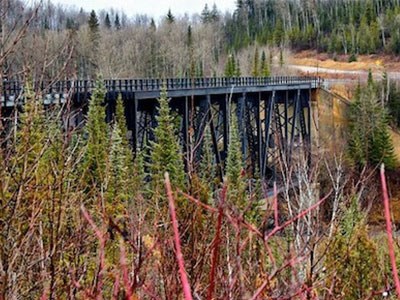Proponents hoping to save the Abitibi River trestle bridge from dereliction now have some numbers to bolster their argument that the span significantly contributes to the lifeblood of the community.
In May, the Iroquois Falls Chamber of Commerce surveyed residents and users and found there’s been a loss of roughly $408,000 in spending in the area since the bridge was closed last August after a pair of engineering reports deemed it was unsafe for use.
It’s the equivalent of spending roughly $2 million a year outside the community on things like groceries, alcohol, restaurants and fuel, notes the report.
But suspicions are the number associated with the loss is actually four to five times higher than what’s been reported.
Built in 1922, the bridge has served as the main conduit for wood fibre transport from the Abitibi River Forest and a vital access point for traditional and recreational use of the area’s natural assets. In December, Resolute Forest Products announced it would permanently close its Iroquois Falls mill, resulting in the loss of one of the span’s main users.
Dan Lefebvre, a member of the Abitibi Black River Outdoor Association, said the numbers aren’t surprising, knowing the community and the bridge’s use by recreational users.
According to Ministry of Transportation estimates, the cost to repair the bridge could reach anywhere from $800,000 to $5 million, a spectrum that reflects the bridge’s future potential uses.
“The number varies because it could be for light traffic or heavy equipment,” Lefebvre said. “Light traffic you’re looking at $890,000. Heavy equipment, it’s more along the lines of $5 million, so there’s more work to be done to support the heavy equipment.”
The Abitibi Trestle Working Group, the organization spearheading the campaign, has come up with a three-pronged approach going forward: petition provincial and federal levels of government for funding; gather stakeholder support; and solicit letters of intent from user groups detailing the value of the asset to their organizations, as well as what kind of financial commitment they’re willing to make.
Lefebvre said it’s been challenging to win favour from stakeholders, who are concerned about liabilities and insurance.
“Everyone’s been sitting back, waiting for something to happen, because once the stakeholders get involved, there will be some cost to them,” Lefebvre said.
But he’s optimistic logging companies like H20 and Georgia Pacific, which harvest wood fibre in the area, might be interested, since taking their trucks the long way around the river, while the bridge is out of service, is costly to operate.
Proponents also have to determine who will take over the bridge’s ownership. Lefebvre said his outdoor association, as well as the working group, have both volunteered their names.
But the feeling is that the municipality would have more pull in getting the province’s ear when it comes to securing infrastructure funding.
Whoever takes over ownership of the bridge will absolve Resolute Forest Products, the current owner, of all liability.
“We’d like to, perhaps in the future, transfer it over to one of the major stakeholders, should they be interested in taking it over,” Lefebvre said. “It’s just kind of a transition phase, the way I see it.”
In the meantime, the bridge is still open to pedestrian traffic, and it’s seen a lot of use.
Lefebvre said people have been using the flanking approaches, almost like parking lots, to leave their vehicles while they carry items across the bridge.
Many then transfer their items to another vehicle to get them to their camps or other destinations.
“It’s encouraging, because it shows the bridge is being used, mostly by recreational users, but by a lot of business as well,” Lefebvre said. “Anyone hitting the community from the north has been using it on a daily basis.”
Resolute is expected to start dismantling the Iroquois Falls mill’s assets by August or September.




